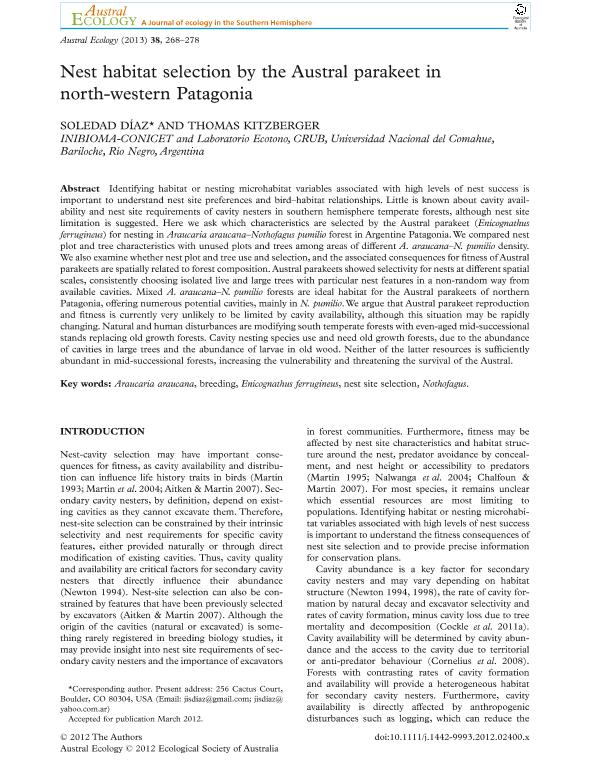Mostrar el registro sencillo del ítem
dc.contributor.author
Diaz, Soledad
dc.contributor.author
Kitzberger, Thomas

dc.date.available
2016-07-26T19:46:05Z
dc.date.issued
2013-04
dc.identifier.citation
Diaz, Soledad; Kitzberger, Thomas; Nest habitat selection by the Austral parakeet in north-western Patagonia; Wiley; Austral Ecology; 38; 3; 4-2013; 268-278
dc.identifier.issn
1442-9985
dc.identifier.uri
http://hdl.handle.net/11336/6706
dc.description.abstract
Identifying habitat or nesting microhabitat variables associated with high levels of nest success is important to understand nest site preferences and bird–habitat relationships. Little is known about cavity availability and nest site requirements of cavity nesters in southern hemisphere temperate forests, although nest site limitation is suggested. Here we ask which characteristics are selected by the Austral parakeet (Enicognathus ferrugineus) for nesting in Araucaria araucana–Nothofagus pumilio forest in Argentine Patagonia.We compared nest plot and tree characteristics with unused plots and trees among areas of different A. araucana–N. pumilio density. We also examine whether nest plot and tree use and selection, and the associated consequences for fitness of Austral parakeets are spatially related to forest composition. Austral parakeets showed selectivity for nests at different spatial scales, consistently choosing isolated live and large trees with particular nest features in a non-random way from available cavities. Mixed A. araucana–N. pumilio forests are ideal habitat for the Austral parakeets of northern Patagonia, offering numerous potential cavities, mainly in N. pumilio.We argue that Austral parakeet reproduction and fitness is currently very unlikely to be limited by cavity availability, although this situation may be rapidly changing. Natural and human disturbances are modifying south temperate forests with even-aged mid-successional stands replacing old growth forests. Cavity nesting species use and need old growth forests, due to the abundance of cavities in large trees and the abundance of larvae in old wood. Neither of the latter resources is sufficiently abundant in mid-successional forests, increasing the vulnerability and threatening the survival of the Austral.
dc.format
application/pdf
dc.language.iso
eng
dc.publisher
Wiley

dc.rights
info:eu-repo/semantics/openAccess
dc.rights.uri
https://creativecommons.org/licenses/by-nc-sa/2.5/ar/
dc.subject
Breeding
dc.subject
Araucaria
dc.subject
Nest Selection
dc.subject
Patagonia
dc.subject.classification
Ecología

dc.subject.classification
Ciencias Biológicas

dc.subject.classification
CIENCIAS NATURALES Y EXACTAS

dc.title
Nest habitat selection by the Austral parakeet in north-western Patagonia
dc.type
info:eu-repo/semantics/article
dc.type
info:ar-repo/semantics/artículo
dc.type
info:eu-repo/semantics/publishedVersion
dc.date.updated
2016-07-22T18:51:20Z
dc.journal.volume
38
dc.journal.number
3
dc.journal.pagination
268-278
dc.journal.pais
Estados Unidos

dc.journal.ciudad
Hoboken
dc.description.fil
Fil: Diaz, Soledad. Consejo Nacional de Investigaciones Científicas y Técnicas. Centro Científico Tecnológico Patagonia Norte. Instituto de Investigación en Biodiversidad y Medioambiente; Argentina. Universidad Nacional del Comahue. Centro Regional Universitario Bariloche. Laboratorio de Ecotono; Argentina
dc.description.fil
Fil: Kitzberger, Thomas. Consejo Nacional de Investigaciones Científicas y Técnicas. Centro Científico Tecnológico Patagonia Norte. Instituto de Investigación en Biodiversidad y Medioambiente; Argentina. Universidad Nacional del Comahue. Centro Regional Universitario Bariloche. Laboratorio de Ecotono; Argentina
dc.journal.title
Austral Ecology

dc.relation.alternativeid
info:eu-repo/semantics/altIdentifier/url/http://onlinelibrary.wiley.com/doi/10.1111/j.1442-9993.2012.02400.x/abstract
dc.relation.alternativeid
info:eu-repo/semantics/altIdentifier/doi/http://dx.doi.org/10.1111/j.1442-9993.2012.02400.x
dc.relation.alternativeid
info:eu-repo/semantics/altIdentifier/doi/10.1111/j.1442-9993.2012.02400.x
Archivos asociados
